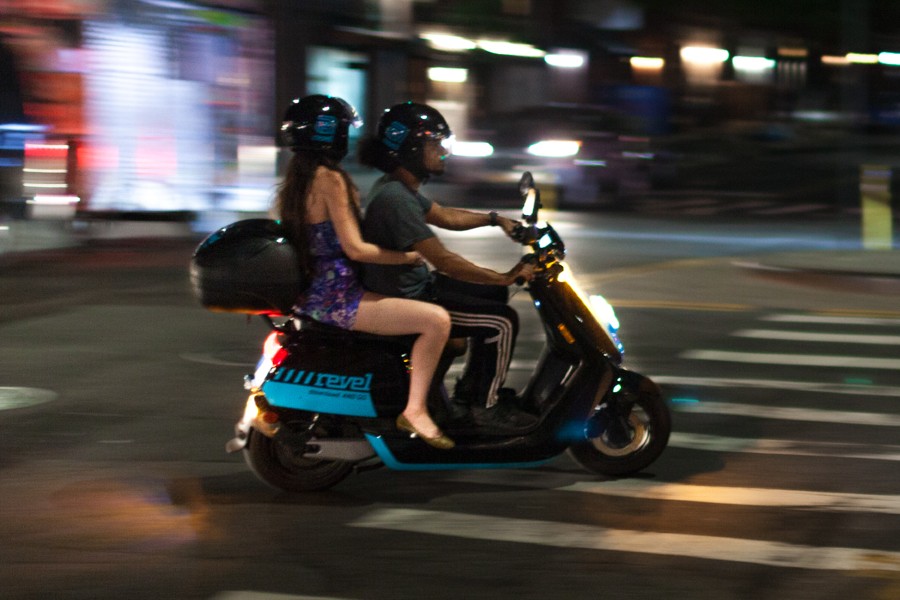 During the 19th century, many Harlem, New York children escaped the heat by swimming in the Hudson or East rivers—they’d either jump off the piers or use enclosed swimming areas called “floating baths.” Swimming in the river was legal, but drownings occurred regularly, and people contracted diseases like polio and typhoid that were transmitted by raw sewage dumped directly into the rivers.
During the 19th century, many Harlem, New York children escaped the heat by swimming in the Hudson or East rivers—they’d either jump off the piers or use enclosed swimming areas called “floating baths.” Swimming in the river was legal, but drownings occurred regularly, and people contracted diseases like polio and typhoid that were transmitted by raw sewage dumped directly into the rivers.
 The city’s first free public floating baths appeared in the Hudson and East Rivers in 1870, and by 1890 there were about 15 such facilities. The baths floated on pontoons and were 95 feet long and 60 feet wide, divided into two sections (one for adults and one for children). The depth of the water was 4 ½ feet in the adult section and 2 ½ feet in the children’s section. The baths were open from late June or early July to early October.
The city’s first free public floating baths appeared in the Hudson and East Rivers in 1870, and by 1890 there were about 15 such facilities. The baths floated on pontoons and were 95 feet long and 60 feet wide, divided into two sections (one for adults and one for children). The depth of the water was 4 ½ feet in the adult section and 2 ½ feet in the children’s section. The baths were open from late June or early July to early October.
In 1895 the New York State legislature passed a law requiring free bathhouses in cities with populations of 50,000 or more. The state, along with then-Mayor William L. Strong, believed it was necessary to provide bathing facilities for “the great unwashed,” or in other words, families in overcrowded tenements. The bathing facilities were primarily for cleansing and therapeutic purposes, but they were also used for recreation when the weather became hot and unbearable.
The Demise of the Harlem Beach Baths
On September 8, 1886, Frederick Kenyon was in the Harlem Court on charges of assaulting some of the female bathers. According to reports, the proprietor of the baths, 21-year-old Louis Fletcher, had been having sexual relations with numerous under-age girls who came to swim at the beach.
The incidents came to light when an Officer Charles Knolls of the New York Society for the Prevention of Cruelty to Children paid a visit to 15-year-old Ruth Levy, who was in prison because her mother objected to her frequent visits to the Harlem Beach Baths and had thus had her committed to the courts. Ruth told the officer that there was a papered-over door that led from the Ladies Toilet of the Bathing Pavilion to Fletcher’s office. Ruth claimed to have seen many girls go through this door, and said Fletcher had sexually assaulted girls while Kenyon was in the room.
On September 19, 1886, the New York Herald reported that the Harlem Beach Baths were still open for swimming and water temperatures were 75 degrees. But less than one month later, on October 8, 1886, a fire destroyed the baths and the pavilion along with over $50,000 worth of property along the East River from 116th to 117th streets.
 Much of the property was owned by Charles M. Vandervoort and William G. Tucker, including several small frame buildings, a two-story frame factory that made paints, oils and cement; a three-story brick building that was used for storing coal and the manufacture of chemicals, varnishes, and brewers’ supplies; and a three-story brick building used by H.C. Campbell as a planing mill and a sash, blind and molding factory.
Much of the property was owned by Charles M. Vandervoort and William G. Tucker, including several small frame buildings, a two-story frame factory that made paints, oils and cement; a three-story brick building that was used for storing coal and the manufacture of chemicals, varnishes, and brewers’ supplies; and a three-story brick building used by H.C. Campbell as a planing mill and a sash, blind and molding factory.
After the fire, there were still a few references to the Harlem Beach Baths. In October 1887, two brothers, John C. and Patrick Cunningham, were “blown to pieces” when a boiler for a steam launch, Katy, exploded. According to an October 24 issue of The Sun, the bodies of the brothers, who worked for the Standard Gas Light Company, were placed on the docks of the Harlem Beach Baths. A personal ad in the New York Herald on July 14, 1889, also makes reference to the Harlem Beach Baths, but the message is cryptic.
In 1903, the Washburn Wire Company of New York occupied 117th to 118th streets on the East River — just one block from where the baths were. The factory, which comprised six buildings, made wire products like springs, piano strings and fence wire. In 1917, the factory was working on a large order from the U.S. government when a disastrous fire broke out in three places. The manager, Daniel C. Turner, told police he suspected that one or more of the 25 German or 200 Austrian workers started the blazes. Two of the buildings survived the fire, and the factory reportedly stayed in business until 1976 (source).
Related articles

Become a Harlem Insider!
By submitting this form, you are consenting to receive marketing emails from: Harlem World Magazine, 2521 1/2 west 42nd street, Los Angeles, CA, 90008, https://www.harlemworldmagazine.com. You can revoke your consent to receive emails at any time by using the SafeUnsubscribe® link, found at the bottom of every email. Emails are serviced by Constant Contact






















